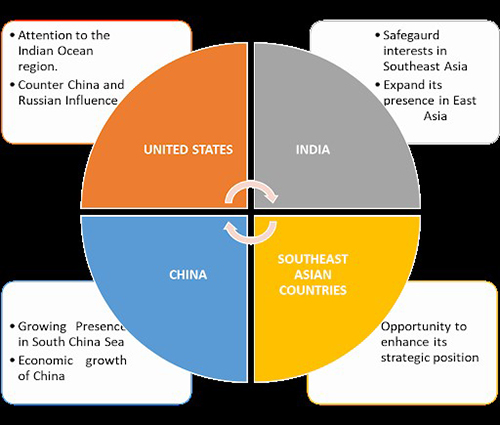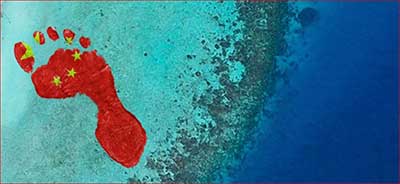Relevance: GS-2: Effect of policies and politics of developed and developing countries on India’s interests, Indian diaspora.
Key Phrases: China-Pacific Island Countries, Pacific Island Countries,Exclusive Economic Zones,Micronesia, Melanesia , Polynesia, natural line of expansion, First Island Chain’.
Context:
- The Foreign Minister of China, is on a visit to ten Pacific Island Countries (PICs), and has co-hosted with Fiji the Second China-Pacific Island Countries Foreign Ministers Meeting on May 30, 2022.
- During the meeting, China’s effort to push through a comprehensive framework deal, the draft of which was leaked earlier, failed to gain consensus among the PICs.
Background:
- In April 2022, China signed a controversial security deal with the Solomon Islands, which raised regional concerns.
- Prior to the current visit, two draft documents prepared by the Chinese side were leaked, and gained the attention of regional leaders in the Pacific as well as the larger international community.
- One of the documents is the “China-Pacific Island Countries (PICs) Common Development Vision”, and the other is “China-Pacific Islands Five-Year Action Plan on Common Development (2022-2026)”.
- The vision gives a broad proposal about co-operation in the political, security, economic and strategic areas, whereas the action plan outlines the more specific details of co-operation in the identified areas.
- The secrecy surrounding the draft, and the haste with which it was discussed with the governments of the PICs during the meeting sent worrying signals across the Pacific.
- China has increasingly started talking about security cooperation in addition to its economic diplomacy towards the PICs.
Pacific Island Countries
- Cluster of 14 States: The Pacific Island Countries are a cluster of 14 states which are located largely in the tropical zone of the Pacific Ocean between Asia, Australia and the Americas.
- They include Cook Islands, Fiji, Kiribati, Republic of Marshall Islands, Federated States of Micronesia (FSM), Nauru, Niue, Palau, Papua New Guinea, Samoa, Solomon Islands, Tonga, Tuvalu and Vanuatu.
- The islands are divided on the basis of physical and human geography into three distinct parts — Micronesia, Melanesia and Polynesia.
- The islands are very small in land area, and are spread wide across the vast equatorial swathe of the Pacific ocean.
Strategic Significance of the PICs
- Exclusive Economic Zones (EEZs):
- Though the countries are some of the smallest and least populated states, they have some of the largest Exclusive Economic Zones (EEZs) in the world.
- Huge economic potential:
- Large EEZs translate into huge economic potential due to the possibility of utilising the wealth of fisheries, energy, minerals and other marine resources present in such zones.
- They prefer to be identified as Big Ocean States, rather than Small Island States.
- In fact, Kiribati and FSM, both PICs, having EEZs larger than that of India.
- Important role in major power rivalry:
- Pacific countries have played an important role in major power rivalry as springboards for power projection and laboratories for developing and demonstrating strategic capabilities.
- The major powers of the colonial era competed with each other to gain control over these strategic territories.
- Major Nuclear Weapon Test Sites:
- Due to the remoteness of these islands from the Soviet Union and major population centres of the world, some of the major nuclear weapon test sites of the U.S., the U.K. and France were located here.
- Mobilise International Opinion:
- In addition, the 14 PICs, bound together by shared economic and security concerns, account for as many number of votes in the United Nations, and act as a potential vote bank for major powers to mobilise international opinion.

What China Seek to Achieve from the PICs?
- Strategic Location:
- The PICs lie in the natural line of expansion of China’s maritime interest and naval power.
- They are located beyond China’s ‘First Island Chain’, which represents the country’s first threshold of maritime expansion.
- The PICs are located geo-strategically in what is referred to by China as its ‘Far Seas’, the control of which will make China an effective Blue Water capable Navy — an essential prerequisite for becoming a superpower.
- Quadrilateral Security Dialogue:
- At a time when the Quadrilateral Security Dialogue has emerged as a major force in the Indo-Pacific vis-à-vis China, the need to influence the PICs have become an even more pressing matter for China.
- Taiwan factor:
- Apart from the vast marine richness of the PICs, the Taiwan factor plays a major role in China’s Pacific calculus.
- China, which considers Taiwan to be a breakaway territory, is preparing for what seems like an inevitable military invasion.
- In this context, it becomes important to break Western domination of island chains of the Pacific which could impede reunification.
- Wooing the PICs away from the West and Taiwan will therefore make the goal of Taiwan’s reunification easier for China.
- Diplomatic recognition:
- China has been successful in getting diplomatic recognition from 10 out of the 14 PICs through its economic largesse. Only four PICs — Tuvalu, Palau, Marshall Islands and Nauru, currently recognize Taiwan.
India in Indo-Pacific
- The Indo-Pacific places significant importance on India by highlighting the country as a key player in the twenty-first century.
- As countries like Australia, Japan, and the United States began to define the Indo-Pacific as the new theater for strategic competition, New Delhi came to assume a central role in their respective policies.
- The rise of China and its expanding economic, political, and military engagements, from Europe and Africa to Asia and the Pacific, were shifting the strategic realities for Canberra, Tokyo, and Washington.
- India’s own approach toward the Indo-Pacific is shaped by a new strategic environment coinciding with the rise of China, particularly in the Indian Ocean region and South Asia.
- While priorities and capabilities remain different, Beijing’s expanding presence across the Indo-Pacific presents a common strategic challenge for Canberra, New Delhi, Tokyo, and Washington.
Significance of Indo-Pacific region for India:
- Strategic significance: The Indo-Pacific is a multi-polar region that accounts for over half of global GDP and population.
- Mineral Resources: Maritime regions have also become important storage areas for essential resources such as fish stocks, minerals, and offshore oil and gas.
- Economic Growth: The Indo-Pacific area accounts for approximately 60% of world GDP, making it the most important contributor to global growth.
- Commerce: Many of the world’s most important choke points for global trade are located in this region, including the Straits of Malacca, which are crucial for global economic growth.

Intensification of diplomacy in the Pacific Islands
- The latest China’s diplomacy towards the Pacific Islands has made the powers that have traditionally controlled the regional dynamics like the U.S. and Australia more cautious.
- The U.S. has started revisiting its diplomatic priority for the region ever since the China-Solomon Islands deal.
- The role played by the U.S. in mobilising opposition against China’s proposed deal could not be ruled out.
- Australia has sent its officials to these countries to revisit their ties and has promised due priority and assistance to these countries.
Conclusion:
- China does not have any particular historical linkages to the PICs unlike the Western powers. Therefore, its interest in the PICs is of relatively recent origin, and is linked to China’s rise in the past few decades.
- The PICs as a collective did not agree to China’s extensive and ambitious proposals, and therefore China failed to get a consensus on the deal.
- However, China can always come back with improvised plan, which is more acceptable and use it to further pursue its final objectives incrementally.
Source: The Hindu
Mains Question:
Q. Why is China interested in the Pacific Island countries? What does China’s inroads into the Pacific mean for regional geopolitics?(250 words).








